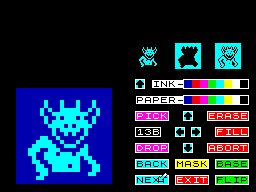
Have you ever wanted to customise a game and put your signature to it? Well now’s your chance with CRL’s 3D Gamemaker. FRANCO FREY gives it a whirl
THE GAME is your typical Knightlore clone with 256 different rooms and the usual objects, obstacles and nasties. Fed up with the standard characters, objects and background, you simply create your own fantasy land or theme park.
The idea is not really all that new. Perhaps older readers may remember that odd excursion into games designing by Quicksilva, Games designer, where several different game structures could be configured from a wide choice of available graphic characters and attack waves. This was fairly limiting though, as it left little creation to the player, just a choice of combinations. Remember the Robin Candy Playing Tips cassette last year, that contained a program by Phil Churchyard which would let the player rearrange the rooms, objects and exits of Sweevo’s World from Gargoyle. Again, it didn’t allow you to create your own graphics. 3D Game Maker does just that.
The package consists of three programs, 3D Graphic Editor, 3D Room Designer and 3D Gamemaker.
As its name implies, the first provides a graphics utility, which accesses the available range of graphic blocks/sprites and allows you to modify or create your very own designs. Each graphic is assigned to a function, ie fixed or moving/crumbling object, background/room border block or player/nasty sprite. This function cannot obviously be changed, only the look of it.

Each graphic requires the generation of a mask to clear the background — but this is made easier by the automatic mask generator, which follows the new object’s outlines and provides a quick starting point for further modification. An individual block can be stored in a temporary buffer, so that it can be copied into the next graphic block — useful for moving sprites or for similar looking objects. The block can be flipped over from left to right and a fill routine provides some further help in the creation of your graphical element. SAVE, VERIFY and LOAD routines are provided for permanent storage.
The 3D Room Designer is a facility for positioning objects and aliens at any point, and for the addition or removal of the exits which connect rooms. The colour of each room can be specified. Each object position requires memory and a memory status indicator displays the amount of memory still left.
The game area is a 16 by 16 matrix of rooms, but only one quarter of this is displayed, with an indicator to indicate which quarter is active. The position of the current room is indicated in the lower right-hand corner of the screen along with the position of the current object within the room. A 15 by 15 matrix shows the horizontal position, and a bar graph the actual height of the object within the room.
The current object can be selected by scanning the complete graphic repertoire for objects and aliens, and the joystick/cursor keys are used to move the object about. An Epson screen dump may be executed for keeping a record of the game area. Generated room data may be saved, verified and loaded from tape for later use.
The 3D Gamemaker is the master program which is required to save the customised version as an autonomous file on cassette. This loads with an example game called 3D Adventure, which can be accessed from the main menu, and which should provide a good example of what can be achieved. The same menu, however, provides the facility of loading the customised graphics and room data. The game can then be tested and, if satisfactory, saved with the appropriate name as an independent game file.
The utility programs are very well presented and designing the graphics and the room layout is simple and enjoyable, as most of the commands are accessed in true point and click style.
If the package were to be judged purely on the merits of the sample game, it would not end up in the top charts, in fact it would be rated as a poor to mediocre version of the particular game style. But with the possibility of creating your very own version, it should interest some of the would-be m/c programmers, who will never make it on their own. As long as nobody expects to create a new games technique with it, 3D Gamemaker should prove to be a versatile utility within the constraints of the program framework, but it’s important to remember that apart from the disposition of the rooms and the objects, it’s only the graphical look of the game that is going to change.